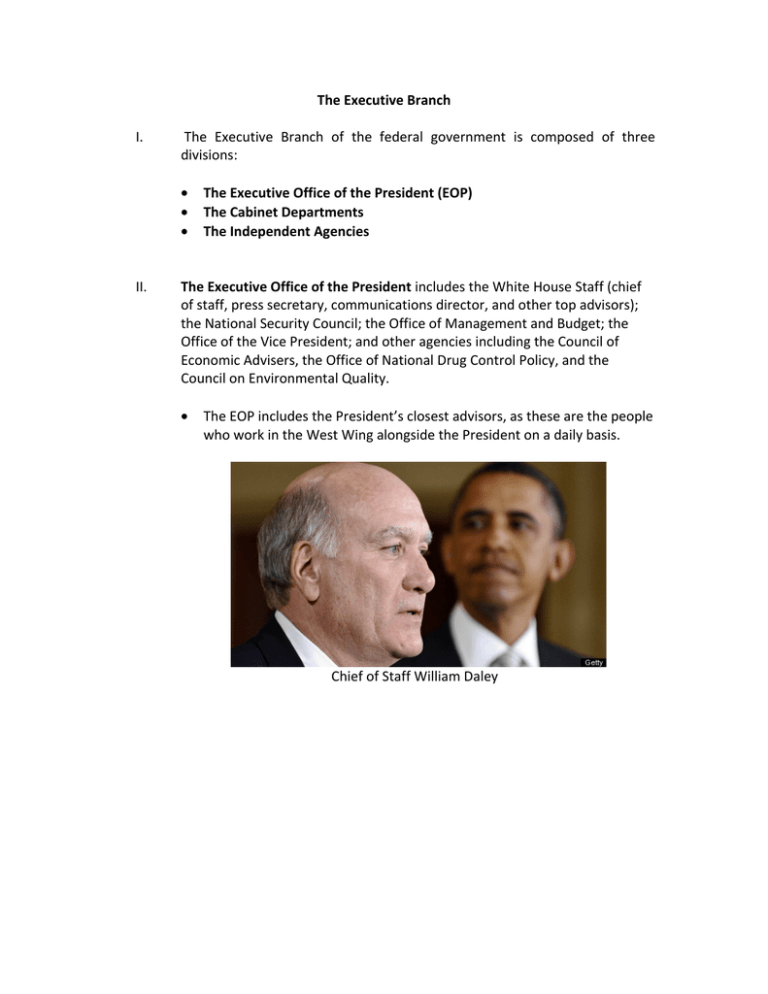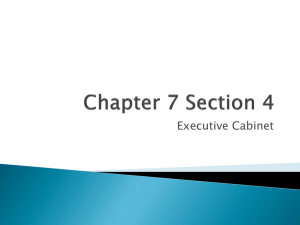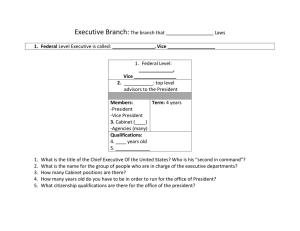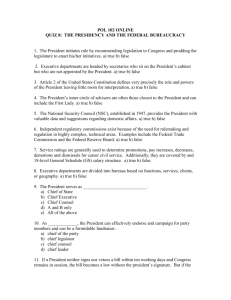Document 14118429
advertisement

I. The Executive Branch The Executive Branch of the federal government is composed of three divisions: • • • II. The Executive Office of the President (EOP) The Cabinet Departments The Independent Agencies The Executive Office of the President includes the White House Staff (chief of staff, press secretary, communications director, and other top advisors); the National Security Council; the Office of Management and Budget; the Office of the Vice President; and other agencies including the Council of Economic Advisers, the Office of National Drug Control Policy, and the Council on Environmental Quality. • The EOP includes the President’s closest advisors, as these are the people who work in the West Wing alongside the President on a daily basis. Chief of Staff William Daley Press Secretary Jay Carney Director of OMB, Jacob Lew III. Presidential Aide Reggie Love The Cabinet Departments • There are 15 Cabinet departments, each of which is headed by a secretary (except for the Justice Department, which is led by the Attorney General) • Attorney General Eric Holder Together, the secretaries make up the President’s Cabinet. Although a Cabinet is not mentioned in the Constitution, each president since George Washington has had one. There were originally just four executive departments, but over time the number has increased to 15. • • In recent decades, presidents have included other top advisors in their meetings and designated them as “Cabinet-­‐level” officials. Over the course of time, the Cabinet has become less influential as a group of advisers to the President. Its advisory role has been largely taken over by the White House Office. However, the Cabinet is still a very important group of administrators, as each Cabinet Department employs thousands of workers and has a budget of millions of dollars. President Barack Obama and Vice President Joe Biden pose with the full Cabinet for an official group photo in the East Room of the White House on Sept. 10, 2009. IV. There are more than 100 independent agencies within the executive branch of the federal government. They are called ‘independent’ because they are not located within any of the 15 Cabinet departments. • The independent agencies fall into three main groups: 1) executive agencies; 2) regulatory commissions; and, 3) government corporations. The Independent Executive Agencies • The twelve regulatory commissions were created in order to regulate important aspects of the nation’s economy. Although they are located within the executive branch, they are largely beyond the reach of presidential direction and control (so that they can operate free of political pressure). Government Corporations • Government corporations have been set up by Congress to carry out certain “businesslike” activities. There are more than 50 government corporations, including the US Postal Service, Amtrak, the FDIC and the Tennessee Valley Authority. • V. Regulatory Commissions • Some of the largest and most important agencies of the federal government fall into this category, including NASA (National Aeronautics and Space Administration), the EPA (Environmental Protection Agency) and the Social Security Administration. Government corporations are organized much like private corporations, and are run by a board of directors and a general manager. When they generate income, it is usually put back into the business. The Civil Service System • The Office of Personnel Management (OPM) is the independent agency that oversees the members of the civil service. These are the career employees who work for the federal government (as opposed to the political appointees who tend to change with the change of each administration). • Since the passage of the Pendleton Civil Service Act of 1883, most of the employees of executive branch agencies are hired by use of the merit system, that is, they are hired on the basis of how well they perform on competitive exams administered by the OPM.





